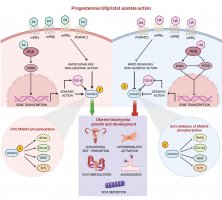Scientists from the Medical University of Białystok and the Department of Biology and Pathology of Reproduction IRZiBŻ PAN in Olsztyn (Gabriela Milewska, Donata Ponikwicka–Tyszko, Piotr Bernaczyk, Oana Lupu, Michal Szamatowicz, Maria Sztachelska, Agata Pilaszewicz-Puza, Mariusz Koda, Tomasz Bielawski, Monika Zbucka-Kretowska, Adam Pawelczyk, Jakub Tomaszewski, Xiangdong Li, Ilpo Huhtaniemi, Slawomir Wolczynski, Nafis A. Rahman) published the article "Functional evidence for two distinct mechanisms of action of progesterone and selective progesterone receptor modulator on uterine leiomyomas" in the prestigious journal Fertility and Sterility.
In the publication, the authors presented the results of research that allowed them to discover and describe two different mechanisms of action of progesterone and the selective progesterone receptor modulator ulipristal acetate in uterine fibroids. Progesterone activates the TGFb and SMAD3 signaling pathways, which stimulates proliferation, growth and accumulation of extracellular matrix. Activation of the nuclear progesterone receptor increases gene expression of this pathway, and activation of membrane progesterone receptors induces a rapid response and phosphorylation of SMAD3. The selective progesterone receptor modulator SMRP (ulipristal), on the other hand, inhibits the TGFb and SMAD3 signaling pathways by decreasing the expression of TGFbRI and RII receptor genes, RhoA, VEGF and fibrosis-related genes COL1A1 and proCOLIA1. Studies have shown that in the biology of fibroids, in addition to nuclear progesterone receptors, membrane progesterone receptors play an important role. The authors of the study suggest that in the pharmacological treatment of fibroids, drugs that modulate the TGFb/SMAD3 pathways can be used in addition to SMRP.
The research was supported by the Polish National Science Centre grant 2016/23/B/NZ5/01477, Medical University of Bialystok grant SUB/1/DN/19/001/1104, Academy of Finland 254366.
Link to the article: Functional evidence for two distinct mechanisms of action of progesterone and selective progesterone receptor modulator on uterine leiomyomas.




